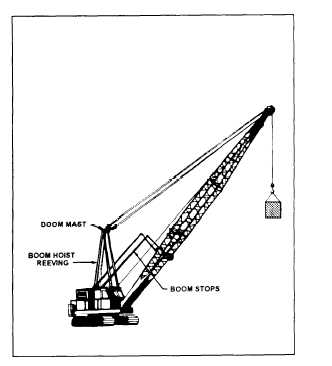boom hoist lines are reeved. The height of the gantry
provides an angle between the boom pendant lines and
boom that reduces the compression forces placed on the
boom during raising and lifting operations. On some
models of cranes, the gantry is adjustable, allowing it to
be lowered so the crane can travel
bridges.
WARNING
Refer to the operator’s
under wires and
manual for
instructions on how to raise and lower the
gantry. A trial-and-error method of lowering or
raising the gantry can cause serious injury or
death.
NOTE: Raising the boom while the gantry is in
the lowered position lowers the angle between the
pendants lines and boom. This places unseen
compression stresses on the boom; therefore, always
raise the gantry before raising the boom or lifting a
load.
Boom Mast
Some models of cranes are equipped with a boom
mast instead of a gantry. The boom mast, sometimes
called live mast, consists of a structural frame hinged
at or near the bottom of the boom butt (fig. 12-19).
Figure 12-19.—Boom mast.
12-10
The tip of the boom mast supports the boom hoist
sheaves and boom pendant lines. The boom mast works
like the gantry, as it increases the angle between the
boom pendants and boom, decreasing the compression
forces placed on the boom.
Bridle Assembly
The bridle assembly is part of the boom
suspension system and is sometimes called a floating
harness. The bridle assembly may be connected to
the boom mast or as a floating harness on a crane
equipped with a gantry. The bridle assembly is the
connection point for the boom pendant lines and is an
assembly of sheaves in which the boom hoist wire
rope reeves through.
Boom Stops
Boom stops are designed to prevent the boom
from going over backwards in case a load line breaks.
They will not stop the boom if the operator forgets to
disengage the boom hoist control lever. However,
some models of cranes are equipped with a boom
upper limit switch that prevents the operator from
raising the boom past a preset boom angle. This
switch also prevents operators from raising the boom
into the boom stops. Most cranes that are equipped
with the upper limit switch also have a bypass switch
that allows the operator to raise the boom past the
preset boom angle.
Two types of boom stops are
shown in figures 12-18 and 12-19.
House Assembly
The house assembly is a revolving superstructure
that sets on top of the carrier frame (fig. 12-20). It
provides a mount for the hoist mechanisms and engine
and is sometimes called the machinery deck. The
operator’s cab and counterweight are attached to the
home assembly.
OPERATOR’S CAB.— The control levers for a
lattice boom crane are located in the operator’s cab. The
control levers that are shown in figure 12-21 are typical
of most cranes.
Typical crane controls areas follows:
1. The swing lever, when pulled towards you,
rotates the house assembly in one direction, and when
pushed, the house assembly rotates in the opposite
direction.



